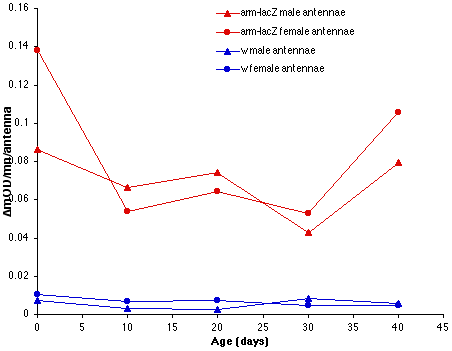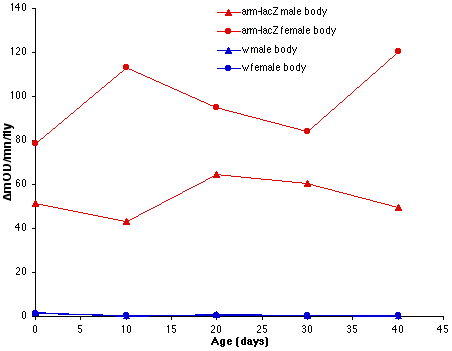CPRG Test
[Principle---Influence of the CPRG substrate concentration---Influence of extract concentration---Sensitivity]
Principle
▀-galactosidase activity was assayed with a
simple liquid ▀-galactosidase assay system that employs CPRG
(chlorophenolred-▀-D-galactopyranoside) as substrate.
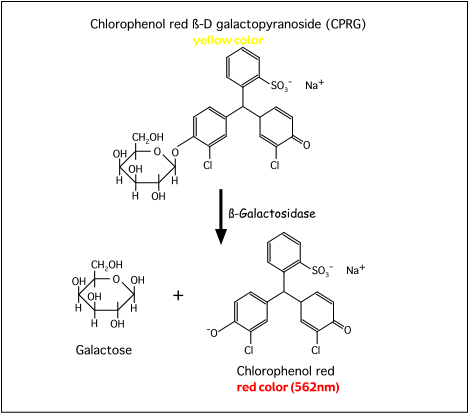
When cleaved by ▀-galactosidase, CPRG yields a water-soluble red
product measurable by spectrophotometry. We chose CPRG over ONPG,
since CPRG is reported to be ten times more sensitive (Simon and Lis, 1987). For crude
fly extracts, CPRG offers the additional advantage over ONPG that
the red product absorbs at a wavelength not significantly
interfered with by fly pigments.
GAL4 males were crossed with UAS-lacZ females. The
progeny from these crosses, carrying both the GAL4 enhancer trap
and the UAS-lacZ reporter, were collected and aged. At different
ages, a single fly was ground up in 100Ál buffer solution (50mM
NaPhosphate, 1mM MgCl2, pH 7.2) containing a mixture of protease
inhibitors (1 Complete Cocktail Tablet for 20ml buffer)(Boehringer-Manheim
cat#1697498). The extract was centrifuged 1mn at 13000rpm, and 10 Ál was reacted with 100Ál CPRG 1mM (Boehringer-Manheim cat#45601222)
in a 96 well micro-plate. A standard micro-plate reader, set at
562nm, was used to measure the increase in absorbance as a
function of time. The enzymatic activity was calculated as the
mOD562nm variation per minute and per fly. To test for background
activity, we measured white and UAS-lacZ flies; they yielded very
low (<1mOD/mn/fly), if any, measurable activity.
Influence of the CPRG substrate concentration
To ensure that the B-galactosidase enzyme was in a substrate-saturated condition, 2 different experiments were run, using our methods of fly cultivation and extraction. Three males were assayed for B-gal activity using 1mM or 2.5 mM of CPRG substrate.
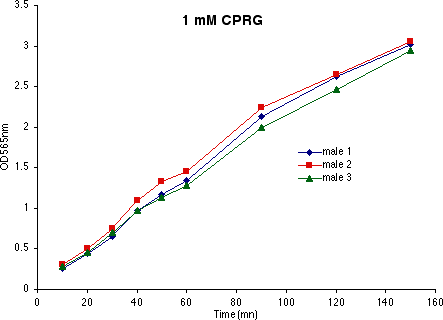
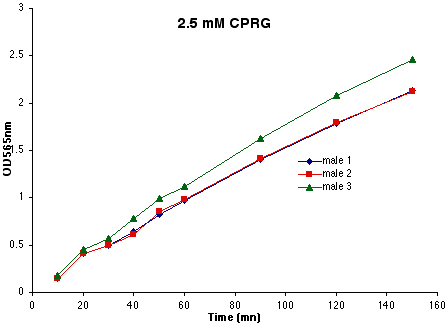
The results show that both concentrations give identical slopes and lead to the same enzymatic activity. This indicates that we are in a substrate-saturated condition and thus the rate of reaction only depends on enzyme concentration.
Influence of extract concentration
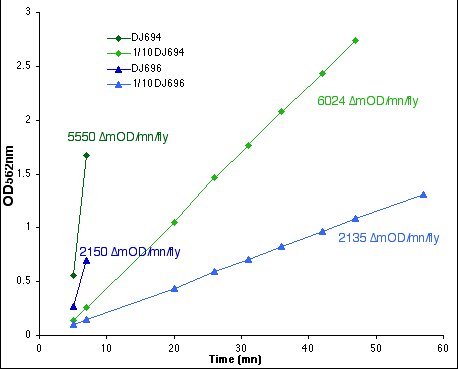
Measuring ten-fold dilutions or crude extracts of the two most active lines (DJ694 and DJ696) show that the relationship between extract concentration and CPRG cleavage was linear over at least a 10-fold range of extract concentration.
Sensitivity
The method is sensitive enough to detect lacZ activity above the background in isolated body parts as antennae. Comparison of body versus antennae activity shows that detection covers more than 3 orders of magnitude.
